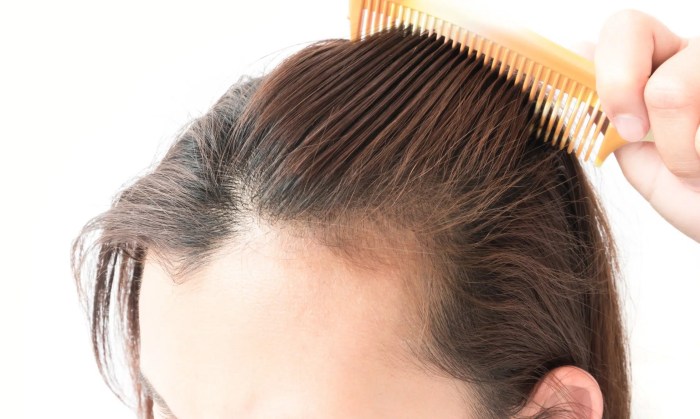The client is experiencing abnormal growth patterns in their hair. – The client is experiencing abnormal growth patterns in their hair, a condition that can have a significant impact on hair health and overall well-being. Understanding the causes, diagnosis, and treatment options for abnormal hair growth is essential for addressing this issue effectively.
This article provides a comprehensive overview of abnormal hair growth patterns, including the potential consequences on hair health, common underlying causes, assessment and diagnosis processes, available treatment options, and preventive measures.
Impact of Abnormal Growth Patterns on Hair Health: The Client Is Experiencing Abnormal Growth Patterns In Their Hair.

Abnormal hair growth patterns can significantly impact hair health. Disruptions in the normal hair growth cycle can lead to various hair-related issues, including:
-
-*Hair loss
Abnormal hair growth patterns can result in excessive hair shedding, leading to thinning hair or baldness.
-*Hair breakage
Weak or brittle hair caused by abnormal growth patterns is more prone to breakage and split ends.
-*Scalp irritation
Abnormal hair growth can irritate the scalp, causing itching, redness, and discomfort.
-*Hair texture changes
Abnormal growth patterns can alter the texture of hair, making it coarse, dry, or frizzy.
Causes of Abnormal Hair Growth Patterns
Numerous factors can contribute to abnormal hair growth patterns, including:
Medical Conditions
-
-*Alopecia areata
An autoimmune condition that causes patchy hair loss.
-*Androgenetic alopecia (male/female pattern baldness)
A genetic condition characterized by gradual hair loss.
-*Hypothyroidism
A condition in which the thyroid gland produces insufficient hormones, leading to hair loss.
-*Telogen effluvium
A temporary hair loss condition caused by stress, illness, or hormonal changes.
Genetic Factors, The client is experiencing abnormal growth patterns in their hair.
-
-*Hair follicle density
The number of hair follicles on the scalp can influence hair growth patterns.
-*Hair shaft diameter
The thickness of individual hair strands can affect hair growth and appearance.
-*Hair growth rate
The speed at which hair grows can vary from person to person and influence overall hair growth patterns.
Lifestyle Choices
-
-*Excessive hair styling
Heat styling, chemical treatments, and tight hairstyles can damage hair and disrupt growth patterns.
-*Poor nutrition
A diet deficient in essential nutrients can lead to hair loss and other hair health issues.
-*Stress
Chronic stress can trigger hair loss and affect hair growth patterns.
Assessment and Diagnosis of Abnormal Hair Growth Patterns

Assessing and diagnosing abnormal hair growth patterns involves a thorough examination by a healthcare professional. The process typically includes:
-
-*Medical history
A detailed account of the patient’s symptoms, including the onset, duration, and any potential triggers.
-*Physical examination
A visual inspection of the scalp and hair to assess hair loss, breakage, or other abnormalities.
-*Diagnostic tests
In some cases, blood tests, scalp biopsies, or other tests may be necessary to determine the underlying cause of abnormal hair growth.
Treatment Options for Abnormal Hair Growth Patterns

Treatment options for abnormal hair growth patterns vary depending on the underlying cause. Some common treatments include:
-
-*Medications
Minoxidil and finasteride are FDA-approved medications used to treat androgenetic alopecia.
-*Hair transplantation
A surgical procedure that involves transplanting healthy hair follicles to areas of hair loss.
-*Laser therapy
Low-level laser therapy can stimulate hair growth and improve hair density.
-*Platelet-rich plasma (PRP) therapy
Involves injecting PRP into the scalp to promote hair growth.
-*Lifestyle modifications
Dietary changes, stress management, and avoiding excessive hair styling can support healthy hair growth.
Prevention and Management of Abnormal Hair Growth Patterns
Preventing and managing abnormal hair growth patterns involves adopting healthy hair care practices and addressing underlying medical conditions. Here are some tips:
-
-*Gentle hair care
Use mild shampoos and conditioners, avoid excessive heat styling, and detangle hair gently.
-*Healthy diet
Include foods rich in protein, iron, and vitamins A, C, and E to support hair growth.
-*Stress management
Engage in stress-reducing activities such as exercise, yoga, or meditation.
-*Medical treatment
Seek medical attention for underlying medical conditions that may contribute to abnormal hair growth patterns.
-*Regular check-ups
Schedule regular check-ups with a dermatologist or hair specialist to monitor hair health and address any concerns promptly.
FAQ Corner
What are the most common causes of abnormal hair growth patterns?
Common causes include genetic factors, hormonal imbalances, medical conditions (e.g., thyroid disorders), nutritional deficiencies, and certain medications.
How is abnormal hair growth diagnosed?
Diagnosis involves a thorough medical history, physical examination, and potentially diagnostic tests (e.g., blood tests, scalp biopsy) to determine the underlying cause.
What are the effective treatment options for abnormal hair growth?
Treatment options vary depending on the underlying cause and may include topical medications, oral medications, laser therapy, and hair transplantation.
Can abnormal hair growth be prevented?
While some causes may not be preventable, maintaining a healthy lifestyle, addressing underlying medical conditions, and practicing proper hair care can help reduce the risk of abnormal hair growth.